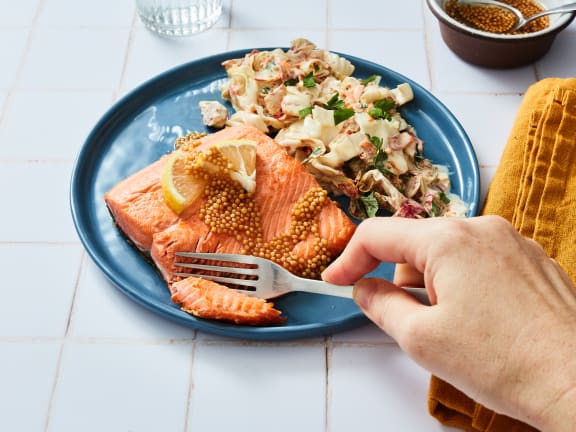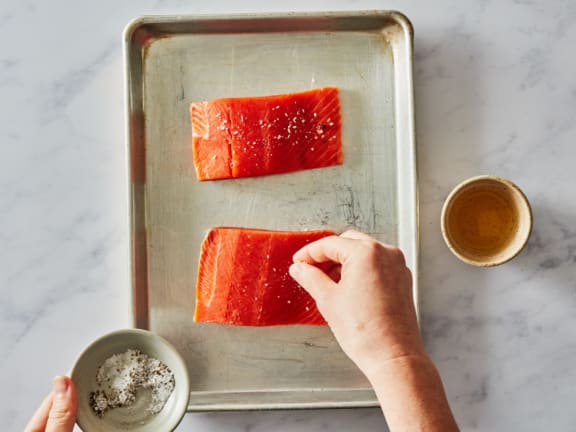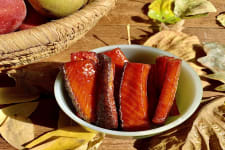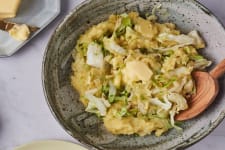Learning how to keep salmon moist is something that any home cook can do with a little attention to time, technique, and adjustment for species, since each salmon species has unique qualities that affect how it cooks. With wild species like sockeye or coho from Alaska, knowing how to not overcook salmon requires a little bit of trial and error in the kitchen, especially if you’re used to preparing farmed Atlantic salmon.
Can you eat overcooked salmon? Of course, but it will lack the tender texture and delicious flavor that you were expecting from your fillet of fish. Here’s how to prepare moist salmon every time:
How to Keep Salmon Moist: Tips and Tricks
Here are some key tips that prevent salmon from drying it out:
-
Don’t season too early: Unless you’re marinating or brining the fish, wait until just before cooking to season the fillets with salt. Over time, salt pulls out moisture from the salmon and can leave behind a less juicy fillet.
-
Use a “barrier”: This tip will come in handy when you’re baking fillets. Olive oil, butter, or even a sauce can serve as a protective barrier between the salmon and the heat, allowing it to cook without losing too much moisture. Herbs, vegetables, and lemon slices can also be used to to fillets as they cook.
-
Leave the skin on: Salmon skin is a built in barrier that will help prevent you from overcooking salmon. Leave the skin on, especially when using high-heat cooking methods.
-
Adjust cooking times: Unless a recipe is written explicitly for wild-caught salmon, you should assume that it was written for farmed fillets. Avoid overcooking your wild salmon by simply reducing the total cooking time.
-
Allow for carryover cooking: A fillet of salmon continues to cook even after you’ve removed it from a heat source. The hotter the heat source, the more it will continue to cook after you’ve transferred the fillet to a serving plate.
How to Tell If Salmon Is Overcooked
What happens if you overcook salmon? The fillet becomes dry and tough, since any juices in the fillet have been cooked out.
You can easily tell if salmon is overcooked by flaking it with a fork. When salmon is perfectly cooked, it flakes easily into large, tender pieces. Overcooking salmon makes it a little more difficult to flake the fillet, and the flakes tend to have a visibly dry, shredded appearance.
You can also use an instant read thermometer to get an idea of if your salmon is too dry:
-
For the most accurate reading, insert the probe of the thermometer into the thickest part of the fillet.
-
Wild-caught fillets of salmon reach a tender medium-rare doneness when cooked to 120F to 125F.
-
Farmed fillets can be cooked to a slightly higher temperature for medium-rare doneness.
-
145F indicates a well-done fillet that is completely cooked through, but may make salmon too dry for your taste.

Is overcooked salmon bad for you?
No. There’s nothing wrong with overcooked salmon — it’s just dry. Overcooked salmon has the same nutritional profile as a fillet that is cooked perfectly.
If you don’t enjoy eating salmon overcooked, don’t throw it away. You can repurpose even the driest fillets to make juicy salmon cakes.

Why is my salmon dry when I cook wild species?
Wild salmon is naturally a lean, nutritious protein — much leaner than farmed salmon due to farmed fish’s imbalanced diet and life of confinement in pens. Leaner, wild salmon will cook faster and is a bit more delicate than farmed salmon, especially when using high-heat cooking methods.
With wild species, is salmon hard to cook?
No, wild salmon isn’t hard to cook. For the best way to cook salmon from Alaska, including ideal cooking times and techniques, check out Wild Alaskan Company’s step-by-step cooking guides.








